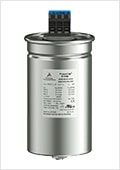source: TDK news
TDK Corporation presents EPCOS PhaseCap® Energy – two new series of high power capacitors for power factor correction. These components are available with gas or resin-filled housings. They are designed for voltages of 230 V AC to 690 V AC and offer a reactive power of between 5 kvar and 33 kvar.
The life expectancy of the B25674* series of gas-impregnated capacitors has been possible to extend by nearly 40 percent from 130,000 to 180,000 hours. The maximum permissible inrush current was also increased by 25 percent to 500 x IR. The new capacitors can also be switched significantly more frequently: For example, the maximum number of switching cycles per year has been doubled from 7500 to 15,000. The maximum permissible operating temperature as per IEC 60831-1 has also now been raised by 5 K to 60 °C.
The B25675* series of resin-filled capacitors features an even longer life expectancy of 200,000 hours and is likewise designed for a maximum operating temperature of 60 °C and a maximum permissible inrush current of 500 x IR.
A further significantly improved feature of both series is their increased energy density in comparison with the existing types: For the 28 kvar / 440 V types, for example, this has been raised by more than 20 percent from 9.7 kvar/l to 11.8 kvar/l. This also results in compact dimensions: The new PhaseCap Energy capacitors feature a diameter of between just 75 mm and 125 mm, depending on the type, and a height of between 164 mm and 224 mm.
Like all EPCOS three-phase PFC capacitors PhaseCap Energy is equipped with an overpressure disconnector that isolates all three phases from the grid in the event of damage.
Main applications
Power factor correction in industrial networks with voltages of between 230 V AC and 690 V AC
Main features and benefits
Life expectancy of up to 200,000 hours
Maximum permissible inrush current of 500 x IR
20 percent higher energy density of up to 11.8 kvar/l
Overpressure disconnector acting on all three phases
Key data
| Series | Impregnation | Rated voltage [V AC] |
Output [kvar] |
Life expectancy [h] |
Max. temperature [°C] |
|---|---|---|---|---|---|
| B25674* | Gas | 230 to 690 | 5 to 33 | 180,000 | 60 |
| B25675* | Resin | 230 to 690 | 5 to 33 | 200,000 | 60 |































